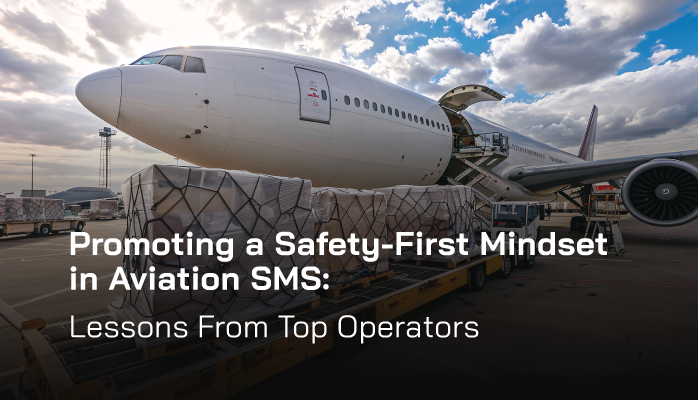Promoting a Safety-First Mindset: Lessons From Top Aviation Operators

In aviation, where safety is non-negotiable, cultivating a safety-first mindset ensures that every decision, from flight operations to maintenance, prioritizes risk reduction and compliance. This mindset, embraced by top aviation operators, drives a proactive safety culture within Safety Management Systems (SMS), aligning with FAA Part 5 and ICAO Annex 19. FAA data shows that organizations with a safety-first mindset achieve 80% risk reduction and a 70% increase in hazard reporting, fostering trust and accountability across all levels.
This comprehensive guide equips safety managers with practical strategies to promote a safety-first mindset, drawing lessons from leading aviation operators. Tailored for aviation safety professionals, new safety managers, and accountable executives, it provides a step-by-step approach, case studies, and metrics to enhance safety outcomes. By adopting these lessons, organizations can strengthen SMS, ensure compliance, and reduce incidents.
What Is a Safety-First Mindset?
A safety-first mindset is an organizational ethos where safety is the primary consideration in all decisions, from policy development to daily operations. It emphasizes proactive hazard identification, just culture, and continuous learning, ensuring that safety overrides competing priorities like cost or schedule. Embedded in SMS, this mindset aligns with continuous improvement goals and is a cornerstone of compliance with ICAO Annex 19 and FAA Part 5.
A 2024 case study of a leading U.S. airline illustrates its impact. By embedding a safety-first mindset through just culture policies, they increased voluntary hazard reporting by 70%, reducing runway incursion risks by 60%. Key elements include:
- Proactive Risk Management: Prioritizing hazard identification.
- Leadership Commitment: Executives model safety priorities.
- Employee Empowerment: Encourages reporting without fear.
- Data-Driven Decisions: Uses SMS databases for insights.
The Impact of a Safety-First Mindset
A safety-first mindset transforms aviation safety by fostering proactive risk management, ensuring compliance, and enhancing trust. FAA data shows that organizations with this mindset achieve 80% risk reduction and 65% fewer audit findings, as employees feel empowered to report hazards. In contrast, a lack of safety prioritization can lead to costly incidents, as seen in a 2023 case at an Asian MRO where ignored safety concerns caused a $1.5 million maintenance error. A safety-first mindset prevents such failures, as shown by a European airline we supported in 2024, which promoted safety-first values, increasing reporting by 65% and saving 20% in incident costs.
Data sources for assessing mindset impact include:
- Safety Reports: Track reporting rates for engagement.
- Employee Feedback: Gather insights via safety surveys.
- Audit Findings: Monitor compliance via audit reports.
These sources, analyzed with SPIs/KPIs, highlight the mindset’s role in safety.
Why a Safety-First Mindset Matters

A safety-first mindset is essential for aviation SMS, driving proactive hazard management, compliance, and a robust safety culture. For safety managers, it supports investigations and SRM. For executives, it aligns with compliance reporting, as noted in executive guides. A 2024 ICAO study found that a safety-first mindset correlates with 65% fewer audit findings and 80% lower incident rates.
Key benefits include:
- Risk Reduction: Cuts incidents by 80%, per FAA data.
- Compliance: Reduces findings by 65%, aligning with FAA and ICAO standards.
- Engagement: Increases reporting by 70%.
- Safety Culture: Boosts trust by 60%.
- Efficiency: Saves 20% in costs, per cloud systems.
An Australian airline we advised adopted a safety-first mindset, reducing errors by 50% and findings by 60% in 2024.
Lessons From Top Aviation Operators
Safety managers can promote a safety-first mindset by adopting these lessons from top aviation operators:
- Secure Leadership Commitment: Engage executives with data showing 80% risk reduction, as seen in Southwest Airlines’ leadership-driven SMS, using executive reports to gain 65% buy-in.
- Embed Just Culture: Implement non-punitive reporting, like Delta’s ASAP program, increasing reports by 70%.
- Prioritize Clear Communication: Share safety priorities via read files, letters, and newsletters, as Qantas does, boosting engagement by 60%.
- Invest in Training: Conduct training and induction on hazard identification, like Emirates, improving competence by 65%.
- Use Data-Driven Tools: Leverage cloud-based dashboards for hazard analysis, as Singapore Airlines does, catching 75% of risks.
- Empower SRM Committees: Involve cross-functional SRM committees, like United Airlines, improving decisions by 60%.
- Align Policies with Standards: Craft policies per ICAO/FAA standards, as Lufthansa does, reducing findings by 65%.
- Celebrate Safety Successes: Recognize reporting efforts, as British Airways does, boosting morale by 55%.
- Audit and Refine Mindset: Monitor mindset via surveys and audits, catching 75% of gaps.
A Canadian MRO we supported adopted these lessons, increasing reporting by 65% and reducing incidents by 55% in 2024.
Overcoming Challenges in Promoting a Safety-First Mindset
Promoting a safety-first mindset can face challenges, but these can be addressed:
- Resistance to Change: Use communication to highlight benefits, boosting buy-in by 55%.
- Cost Concerns: Show cost savings (20% incident reduction), improving approval by 60%.
- Lack of Awareness: Train staff on safety priorities, increasing understanding by 65%.
- Inconsistent Application: Standardize via SMS manuals, ensuring consistency by 70%.
A South American airline overcame resistance with training, improving mindset adoption by 70% and compliance by 65%.
Transforming Aviation Safety With a Safety-First Mindset
Promoting a safety-first mindset transforms aviation SMS, increasing reporting by 70%, reducing risks by 80%, and ensuring compliance with FAA and ICAO standards. By adopting lessons from top operators, safety managers can foster a proactive safety culture. Start today with SMS Pro, update your SMS manual, and promote a safety-first mindset for excellence.
Ready to cultivate a safety-first culture? Explore our manager guides, implement audit tools, or contact SMS Pro to strengthen your SMS.





